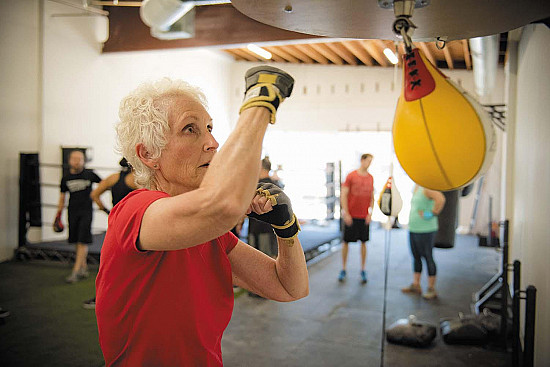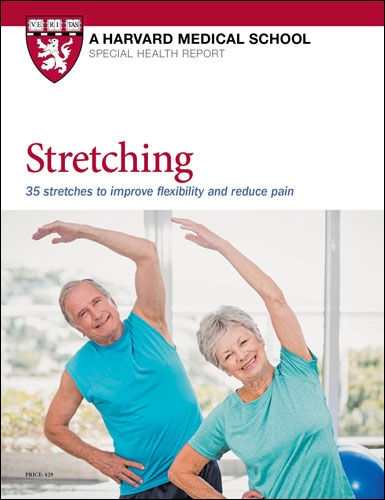Is it too late to save your posture?
Even if your posture has been a problem for years, it's possible to make improvements.
- Reviewed by Anthony L. Komaroff, MD, Editor in Chief, Harvard Health Letter; Editorial Advisory Board Member, Harvard Health Publishing

Rounded shoulders and a hunched stance may seem like they're set in stone by the time we reach a certain age, and you may feel you've missed the boat for better posture. But there's a good chance you can still stand up taller.
It's not as hard as you may think. Better posture is often just a matter of changing your activities and strengthening your muscles.
What causes posture problems?
Poor posture often stems from modern-day habits like working in front of a computer, slouching on a couch while watching TV, or looking down at a smartphone. Poor posture could also be due to many hours spent carrying heavy objects (like equipment at work, grocery bags, or a heavy purse).
All of these activities can make you stoop or bring your shoulders forward. This overstretches and weakens the muscles in the back of your shoulders, and shortens the muscles in the front of your shoulders and in your chest. Gravity then pulls the muscles forward, because the muscles are too weak to pull them back up.
If the core muscles in your back and abdomen have grown weak from inactivity, that can also cause you to lean forward. Those muscles are crucial to lifting your frame and keeping you upright.
Another cause of poor posture, as we reported in September, comes from broken bones in your back. People with brittle bones (osteoporosis) may experience compression fractures when the bones in the back (vertebrae) aren't strong enough to support the load placed on them. The bone collapses on the front side, the part closest to the chest. As collapsed vertebrae stack up, the spine becomes rounded and bends forward, a condition called dowager's hump (dorsal kyphosis).
Poor posture consequences
Sometimes people ask, "Why should I change my posture? I don't mind it." But one of the big things that happens with forward posture is that your center of gravity goes forward. This increases the risk of falling. Poor posture can also cause back or neck pain, headaches, trouble breathing, or trouble walking.
Move of the month: Seated chest stretch
Sit up straight facing sideways in a chair. Clasp your hands behind you, locking your fingers so your palms face you. Lift your hands upward to the point of tightness. Hold 10 seconds and return to the starting position. Repeat two to four times. Photo by Michael Carroll |
Perk up your posture
If you have a spinal cord injury or you've had surgery to fuse or remove bones in your back, there may be some limitations to your posture improvement.
Otherwise, it's usually not too late to correct posture, even if you've had broken vertebrae (once they've healed and your doctor says it's okay). In that case, we'd try to prevent fractures in other segments of your back. We can't change bones, but we can change muscle mass.
Tips to stand taller
The key to fixing poor posture is strengthening and stretching the muscles in the upper back, chest, and core.
Shoulder strengtheners include scapula squeezes (squeezing your shoulder blades together for 30 seconds at a time) and rows (using a resistance band to pull back your elbows like you're rowing).
Core strengtheners include modified planks (in which you hold a push-up position while propped up on your elbows) or simply tightening your abdominal muscles, pulling your navel in toward your spine.
An easy way to stretch your chest muscles: simply put your arms behind your back, grasp both elbows (or forearms if that's as far as you can reach), and hold the position.
You'll also have to work on your posture in everyday activities. A simple trick when you're sitting (even watching TV): Put a rolled towel behind your shoulders. It makes you sit up straight so the towel won't fall.
Cut down on activities that have led to poor posture, too. Take breaks from computer and TV time, and exercise more.
Image: © Ridofranz/Getty Images
About the Author

Heidi Godman, Executive Editor, Harvard Health Letter
About the Reviewer

Anthony L. Komaroff, MD, Editor in Chief, Harvard Health Letter; Editorial Advisory Board Member, Harvard Health Publishing
Disclaimer:
As a service to our readers, Harvard Health Publishing provides access to our library of archived content. Please note the date of last review or update on all articles.
No content on this site, regardless of date, should ever be used as a substitute for direct medical advice from your doctor or other qualified clinician.

















